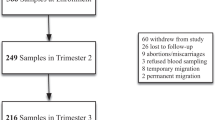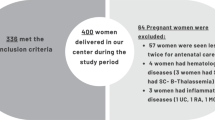Abstract
Objective:
The determinants of anemia during both pregnancy and postpartum recovery remain incompletely understood in sub-Saharan African women.
Subjects/methods:
In a prospective cohort study among pregnant women, we assessed dietary, biochemical, anthropometric, infectious and sociodemographic factors at baseline. In multivariate Cox proportional hazards models, we examined predictors of incident anemia (hemoglobin <11 g/dl) and iron deficiency anemia (anemia plus mean corpuscular volume <80fL), and recovery from anemia and iron deficiency anemia through 18 months postpartum at antenatal clinics in Dar es Salaam, Tanzania between 2001 and 2005. A total of 2364 non-anemic pregnant women and 4884 anemic women were enrolled between 12 and 27 weeks of gestation.
Results:
In total, 292 women developed anemia during the postpartum period and 165 developed iron deficiency anemia, whereas 2982 recovered from baseline anemia and 2044 from iron deficiency anemia. Risk factors for postpartum anemia were delivery complications (RR 1.6, 95% confidence interval (CI) 1.13, 2.22) and low postpartum CD4 cell count (RR 1.73, 95% CI 0.96, 3.17). Iron/folate supplementation during pregnancy had a protective relationship with the incidence of iron deficiency anemia. Absence of delivery complications, education status and iron/folate supplementation were positively associated with time to recovery from iron deficiency.
Conclusion:
Maternal nutritional status during pregnancy, prenatal iron/folate supplementation, perinatal care, and prevention and management of infections, such as malaria, are modifiable risk factors for the occurrence of, and recovery from, anemia.
This is a preview of subscription content, access via your institution
Access options
Subscribe to this journal
Receive 12 print issues and online access
$259.00 per year
only $21.58 per issue
Buy this article
- Purchase on Springer Link
- Instant access to full article PDF
Prices may be subject to local taxes which are calculated during checkout


Similar content being viewed by others
References
Worldwide prevalence of anemia 1993-2005. WHO 2008. ISBN No. 978 92 4 159665 7 http://www.who.int/vmnis/publications/anaemia_prevalence/en/ ; (accessed March 30, 2013).
Stoltzfus RJ . Iron deficiency: global prevalence and consequences. Food Nutr Bull 2003; 24 (4 Suppl), S99–103.
Pena-Rosas JP, Viteri FE . Effects and safety of preventive oral iron or iron+folic acid supplementation for women during pregnancy. Cochrane Database Syst Rev 2009; CD004736.
Mungen E . Iron supplementation in pregnancy. J Perinat Med 2003; 31: 420–426.
Weiss G, Goodnough LT . Anemia of chronic disease. N Engl J Med 2005; 352: 1011–1023.
Brabin BJ, Premji Z, Verhoeff F . An analysis of anemia and child mortality. J Nutr 2001; 131: 636S–645SS., discussion 46S-48S.
Marchant T, Schellenberg JA, Nathan R, Abdulla S, Mukasa O, Mshinda H et al. Anaemia in pregnancy and infant mortality in Tanzania. Trop Med Int Health 2004; 9: 262–266.
Ngnie-Teta I, Kuate-Defo B, Receveur O . Multilevel modelling of sociodemographic predictors of various levels of anaemia among women in Mali. Public Health Nutr 2009; 12: 1462–1469.
Scholl TO, Hediger ML, Fischer RL, Shearer JW . Anemia vs iron deficiency: increased risk of preterm delivery in a prospective study. Am J Clin Nutr 1992; 55: 985–988.
Lopez de Romana G, Cusirramos S, Lopez de Romana D, Gross R . Efficacy of multiple micronutrient supplementation for improving anemia, micronutrient status, growth, and morbidity of Peruvian infants. J Nutr 2005; 135: 646S–652SS.
Massawe SN, Urassa EN, Mmari M, Ronquist G, Lindmark G, Nystrom L . The complexity of pregnancy anemia in Dar-es-Salaam. Gynecol Obstet Invest 1999; 47: 76–82.
Watson-Jones D, Weiss HA, Changalucha JM, Todd J, Gumodoka B, Bulmer J et al. Adverse birth outcomes in United Republic of Tanzania–impact and prevention of maternal risk factors. Bull World Health Organ 2007; 85: 9–18.
Christian P, Stewart CP, LeClerq SC, Wu L, Katz J, West KP Jr. et al. Antenatal and postnatal iron supplementation and childhood mortality in rural Nepal: a prospective follow-up in a randomized, controlled community trial. Am J Epidemiol 2009; 170: 1127–1136.
Dibley MJ, Titaley CR, d’Este C, Agho K . Iron and folic acid supplements in pregnancy improve child survival in Indonesia. Am J Clin Nutr 2012; 95: 220–230.
Titaley CR, Dibley MJ, Roberts CL, Agho K . Combined iron/folic acid supplements and malaria prophylaxis reduce neonatal mortality in 19 sub-Saharan African countries. Am J Clin Nutr 2010; 92: 235–243.
Bodnar LM, Cogswell ME, McDonald T . Have we forgotten the significance of postpartum iron deficiency? Am J Obstet Gynecol 2005; 193: 36–44.
Bodnar LM, Scanlon KS, Freedman DS, Siega-Riz AM, Cogswell ME . High prevalence of postpartum anemia among low-income women in the United States. Am J Obstet Gynecol 2001; 185: 438–443.
Chersich MF, Luchters SM, Yard E, Othigo JM, Kley N, Temmerman M . Morbidity in the first year postpartum among HIV-infected women in Kenya. Int J Gynaecol Obstet 2008; 100: 45–51.
Isanaka S, Duggan C, Fawzi WW . Patterns of postnatal growth in HIV-infected and HIV-exposed children. Nutr Rev 2009; 67: 343–359.
Antelman G, Msamanga GI, Spiegelman D, Urassa EJ, Narh R, Hunter DJ et al. Nutritional factors and infectious disease contribute to anemia among pregnant women with human immunodeficiency virus in Tanzania. J Nutr 2000; 130: 1950–1957.
Ganz T . Hepcidin, a key regulator of iron metabolism and mediator of anemia of inflammation. Blood 2003; 102: 783–788.
Fawzi WW, Msamanga GI, Urassa W, Hertzmark E, Petraro P, Willett WC et al. Vitamins and perinatal outcomes among HIV-negative women in Tanzania. N Engl J Med 2007; 356: 1423–1431.
Cox DR . Regression models and life tables. J R Stat Soc Series B 1972; 187–220.
Durrleman S, Simon R . Flexible regression models with cubic splines. Stat Med 1989; 8: 551–561.
Govindarajulu US, Spiegelman D, Thurston SW, Ganguli B, Eisen EA . Comparing smoothing techniques in Cox models for exposure-response relationships. Stat Med 2007; 26: 3735–3752.
Andersen PKaG RD . Cox’s regression model counting process: a large sample study. Ann Stat 1982; 10: 1100–1120.
Tanzania Demographic and Health Survey 2004-2005. DHS, 2005.
Isanaka S, Mora-Plazas M, Lopez-Arana S, Baylin A, Villamor E . Food insecurity is highly prevalent and predicts underweight but not overweight in adults and school children from Bogota, Colombia. J Nutr 2007; 137: 2747–2755.
Krummel D, Kris-Etherton P . Nutrition in Women’s Health. Aspen Publishers, Inc: Gaithersburg. p 582, 1996.
Lartey A . Maternal and child nutrition in Sub-Saharan Africa: challenges and interventions. Proc Nutr Soc 2008; 67: 105–108.
Makola D, Ash DM, Tatala SR, Latham MC, Ndossi G, Mehansho H . A micronutrient-fortified beverage prevents iron deficiency, reduces anemia and improves the hemoglobin concentration of pregnant Tanzanian women. J Nutr 2003; 133: 1339–1346.
Ramakrishnam U (ed). Nutritional Anemias. CRC Press, 2001.
Ramakrishnam U, Manjrekrar R, Rivera J, Gonzales-Cossio T, Martorell R . Micronutrients and pregnancy outcomes: a review of the literature. Nutr Res 1999; 19: 103–159.
Rozenberg G . Microscopic Haematology: A Practical Guide for the Laboratory. In: Dunitz M, (ed)., Martin Dunitz: London. p 230, 2003.
Shashiraj, Faridi MM, Singh O, Rusia U . Mother’s iron status, breastmilk iron and lactoferrin—are they related? Eur J Clin Nutr 2006; 60: 903–908.
Teixeira Mde L, Lira PI, Coutinho SB, Eickmann SH, Lima MC . Influence of breastfeeding type and maternal anemia on hemoglobin concentration in 6-month-old infants. J Pediatr 2010; 86: 65–72.
Shell-Duncan B, Yung SA . The maternal depletion transition in northern Kenya: the effects of settlement, development and disparity. Soc Sci Med 2004; 58: 2485–2498.
Maruti SS, Feskanich D, Rockett HR, Colditz GA, Sampson LA, Willett WC . Validation of adolescent diet recalled by adults. Epidemiology 2006; 17: 226–229.
Hernandez-Avila M, Romieu I, Parra S, Hernandez-Avila J, Madrigal H, Willett W . Validity and reproducibility of a food frequency questionnaire to assess dietary intake of women living in Mexico City. Salud Publica Mex 1998; 40: 133–140.
Suitor CJ, Gardner J, Willett WC . A comparison of food frequency and diet recall methods in studies of nutrient intake of low-income pregnant women. J Am Diet Assoc 1989; 89: 1786–1794.
Abrams ET, Kwiek JJ, Mwapasa V, Kamwendo DD, Tadesse E, Lema VM et al. Malaria during pregnancy and foetal haematological status in Blantyre, Malawi. Malar J 2005; 4: 39.
Brabin B . Malaria in pregnancy: current issues. Afr Health 1997; 19: 19–20.
Ekvall H . Malaria and anemia. Curr Opin Hematol. 2003; 10: 108–114.
Ratledge C . Iron metabolism and infection. Food Nutr Bull 2007; 28 (4 Suppl), S515–S523.
Uneke CJ . Impact of placental Plasmodium falciparum malaria on pregnancy and perinatal outcome in sub-Saharan Africa: I: introduction to placental malaria. Yale J Biol Med 2007; 80: 39–50.
Isanaka S, Mugusi F, Urassa W, Willett WC, Bosch RJ, Villamor E et al. Iron deficiency and anemia predict mortality in patients with tuberculosis. J Nutr 2012; 142: 350–357.
Nutritional Concerns of Women, Wolinsky I, Klimis-Tavantzis D (eds). Nutritional Concerns of Women. CRC Press: Boca Raton, FL, USA. p 335, 1996.
Dacie JV . Practical Hematology 1991. Longman Group: UK, 1991.
Dim CC, Onah HE . The prevalence of anemia among pregnant women at booking in Enugu, South Eastern Nigeria. Med Gen Med 2007; 9: 11.
Dijkhuizen MA, Wieringa FT, West CE, Muherdiyantiningsih, Muhilal . Concurrent micronutrient deficiencies in lactating mothers and their infants in Indonesia. Am J Clin Nutr 2001; 73: 786–791.
Acknowledgements
This work was supported by the National Institute of Child Health and Human Development (NICHD R01 37701), (clinicaltrials.gov #NCT00197548). CD was supported in part by NICHD K24HD058795. Research reported in this publication (AM) was supported by the Fogarty International Center of the National Institutes of Health under Award Number U2RTW008254. The content is solely the responsibility of the authors and does not necessarily represent the official views of the National Institutes of Health.
Author information
Authors and Affiliations
Corresponding author
Ethics declarations
Competing interests
The authors declare no conflict of interest.
Rights and permissions
About this article
Cite this article
Petraro, P., Duggan, C., Urassa, W. et al. Determinants of anemia in postpartum HIV-negative women in Dar es Salaam, Tanzania. Eur J Clin Nutr 67, 708–717 (2013). https://doi.org/10.1038/ejcn.2013.71
Received:
Revised:
Accepted:
Published:
Issue Date:
DOI: https://doi.org/10.1038/ejcn.2013.71



